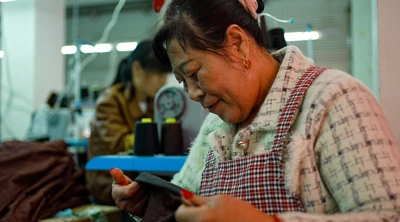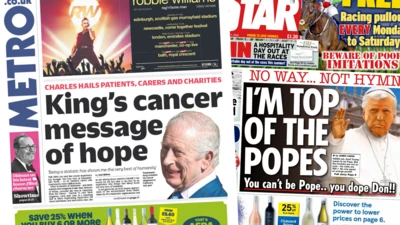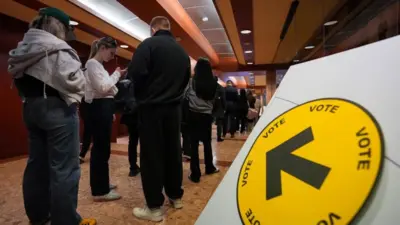'Vauxhall was shaped by family and a can-do spirit'
Image source, EveningStandard/Hulton Archive/Getty Images
- Author, Zoe Applegate
- Role, BBC News, Bedfordshire
The last van has rolled off the Vauxhall production line 120 years after the company relocated to Luton. The closure has seen former director and historian Ian Coomber reminiscing about life at the manufacturing giant.
Image source, The Coombers
The image of lines of buses, parked along the main road as far as the eye could see, is seared into the memory of Ian Coomber, who joined Vauxhall as a technical apprentice in 1963.
The buses were waiting and ready to pick up some of the Luton plant's 24,000 workers.
As a boy, Mr Coomber enjoyed a love of cars, but growing up in Brighton on the south coast he had no experience of living in a place shaped by the industry.
Image source, Stellantis
Vauxhall had been the only car manufacturer to offer a training scheme for those wanting to pursue a degree at that time.
After an "Apprentice-style" interview, with applicants divided into groups and sent running round the sprawling site to find all manner of strangely-named items, he was one of a handful of people to be awarded a traineeship.
Image source, Stellantis
In those days, the Luton plant did not have any proper car parks and most workers arrived by bicycle or bus.
During each shift - with the site running 24 hours a day - the gates were shut to the employees until the "hooters" would sound to let everyone know they could go home.
"To my Brighton eyes, it was amazing," said Mr Coomber.
"There would be 30-40 buses rowed down Kimpton Road and when the hooter went up, the buses would fill."
Image source, Stellantis
After completing his mechanical engineering degree at Edinburgh University and going back to work at Luton full-time, it did not take Mr Coomber long to work out what made Vauxhall tick as one of the UK's leading manufacturers.
"Family and a can-do spirit - that was it," said Mr Coomber.
"There was this Vauxhall-ness that ran through everything.
"Vauxhall had always been about the people... in the 1930s when it was a mini-Detroit they would put people on maintenance rather than lay them off like other places in Coventry, etc.
"The other manufacturers used to refer to Luton as the 'turnip patch', because everything was so tranquil."
Such was Vauxhall's overriding importance and legacy in the Bedfordshire town, families would covet apprenticeships for their children.
Employees' offspring would be awarded extra points on their job applications to boost their chances.
"[Vauxhall] set up this idea of family because the father would get his son an apprenticeship and that son would go on to try to get his son an apprenticeship - because it was almost surety of a decent job," said Mr Coomber.
"It had all kinds of dynasties in it."
Image source, Stellantis
Image source, Vauxhall Heritage
Perks such as being able to fish at some of the best riverside spots in the county, membership of the then nationally renowned Vauxhall men's choir and access to its sprung ballroom floor in the canteen building, were also only open to staff.
Recreational facilities were based in the "impressive-looking" canteen building, stood on a hill, with a "club for everything".
"It was a circular sort of thing - you worked for Vauxhall and Vauxhall did stuff for you," said Mr Coomber.
Image source, Stellantis
Managers were also aware of trying to relieve the monotony of working on the production line.
Celebrities of the time, such as the actor Anthony Newley and even the London Philharmonic Orchestra, would perform on the canteen's huge stage for broadcasts of the BBC radio's lunchtime roadshow, Workers' Playtime, to boost morale.
Image source, Vauxhall Heritage
It was a formula that bolstered the original blueprint that the US-based General Motors had been forced to find when it bought the floundering company in 1925 as it looked to gain a foothold in Europe.
"They didn't get the product right for a long time - the cars were too expensive, too rooted in the past and it took until 1931 and the appointment of [managing director Charles] Bartlett, who was a driving force, to get the right cars for the UK market," said Mr Coomber.
Image source, Vauxhall Heritage
Image source, Stellantis
Mr Coomber said he was aware of how fundamental the mass market choice, the Cavalier, had been to the car maker's fortunes.
Brought out in 1981, Mr Coomber said it gained a 17% market share and was valued by both fleet and retail customers for its huge mileage, while being economical and stylish.
Prices could also be pushed up through optional extras such as CD players and electric windows.
Image source, PA Media
"Then we got into the limited editions and very pretentiously we called one the Antibes," recalled Mr Coomber.
"I can remember going into a dealer showroom and the salesman said 'we got a new Anti Bees one in the other day' and I thought 'Oh God'.
"The dealers were at the sharp end - they were the guys who told you whether you got it right or wrong."
Do you have a story suggestion for Beds, Herts & Bucks?
Follow Beds, Herts and Bucks news on BBC Sounds, Facebook, Instagram and X.
Top Stories
More to explore
Popular Reads
Content is not available








